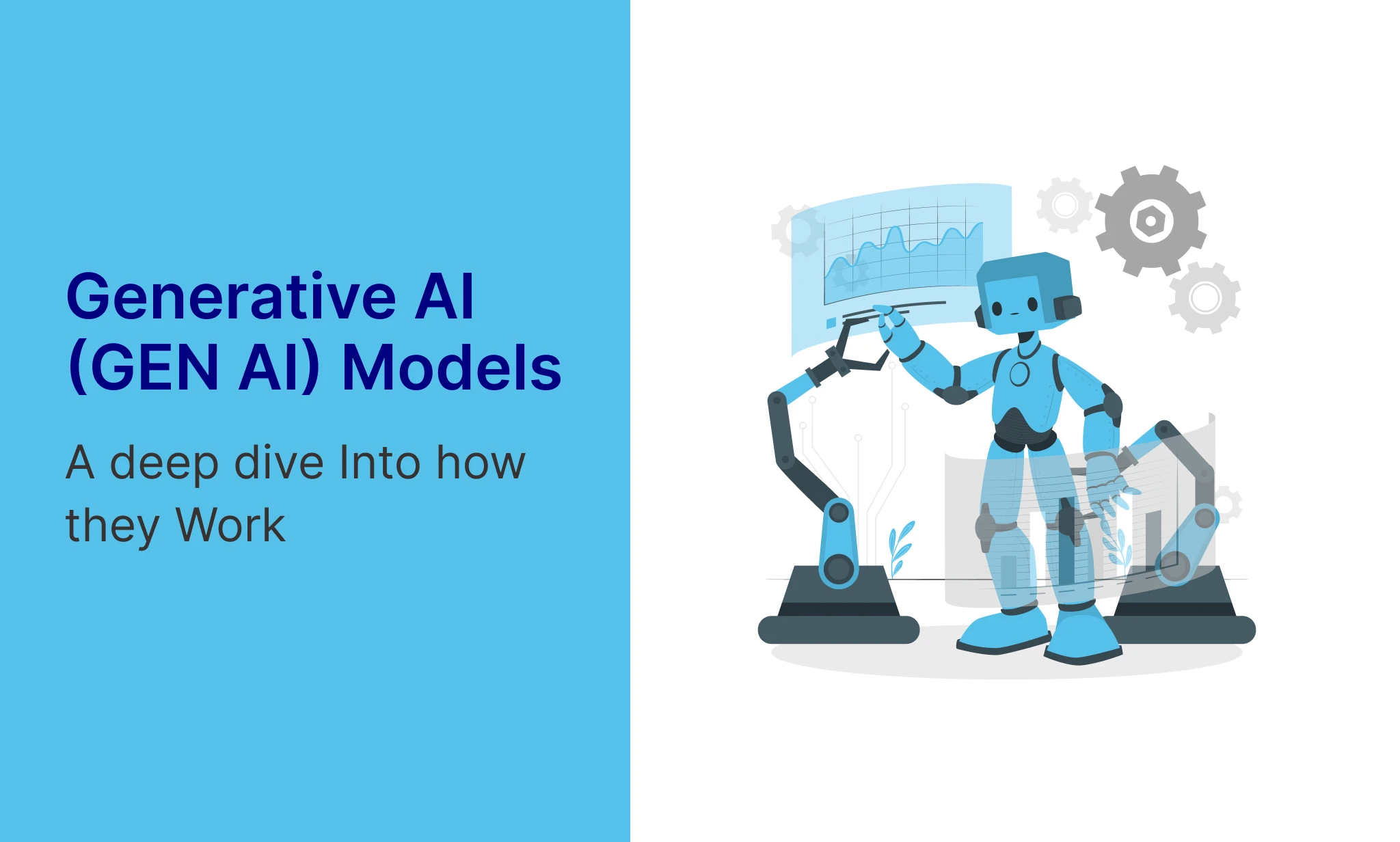Table of Contents
A Deep Dive Into How They Work
Generative AI (GEN AI) Models: A Deep Dive Into How They Work
The data revolution has paved the way for disruptive technologies like machine learning (ML) and artificial intelligence (AI) to take the front stage. With more time, these tools have advanced beyond their traditional purpose of analyzing massive datasets and extracting valuable insights.
That said, let’s dive straight into Generative AI models today. Simply put, artificial intelligence can create new and original content, such as images, text, or even music, based on patterns it learns from existing data.
Generative AI companies and platforms are the primary players powering the tools that drive AI innovation. Although they are less popular than other AI companies, they are emerging. Gartner states that by 2027, around 30% of Fortune 500 companies will use Generative AI to streamline post-purchase activities.
Let’s discuss this in a little more detail here.
How Generative AI Models Work
Generative AI works by training models to recognize patterns in data, enabling them to create new content. Unlike traditional AI, it doesn’t always need labeled data; instead, it uses unsupervised or semi-supervised learning.
These models analyze uncategorized data from sources like the internet and spot recurring patterns and relationships. Their architecture, designed like interconnected neurons, helps them mimic human-like content by continuously learning from vast datasets.
In a nutshell, Generative AI learns from data to create new content.
Benefits of Using Generative AI Tools
Generative AI tools empower users with enhanced capabilities by offering the following benefits:
- Data augmentation: Generative models excel at creating synthetic data, addressing challenges associated with obtaining labeled data in real-world scenarios. This facilitates effective training of other machine learning models.
- Understanding and simulating NLP (Natural Learning Process): Generative AI models power chatbots and virtual assistants capable of learning and generating human-like responses. They also play a vital role in creating high-quality text for various content assets.
- Creative applications: These tools unlock creative potential by generating art, poetry, music, and other artistic works. One of the most significant Generative AI examples is GPT DALL-E. With this version of GPT, you can create advanced visualizations and images in various styles and themes.
- Versatility: Generative AI tools offer versatility in many tasks, such as translation, summarization, question answering, and more. They can be tailored to different industries and domains. Users can also control the output style according to their preferences and needs.
| Reap the ultimate benefits of Generative AI for business by partnering with Byteridge. <Exlpore now!> |
Generative AI Types
Generative AI models have a wide range of use cases that drive innovation and creativity in many industrial sectors.
- Generative Adversarial Networks (GANs): These models create images and synthetic data by training two neural networks to compete against each other, resulting in realistic outputs.
- Transformer-based models: These models are primarily used for generating text and completing content or code. Transformer-based models like GPT and BERT use attention mechanisms to understand and produce contextually relevant outputs.
- Diffusion models: These models specialize in image generation and video synthesis. They use a probabilistic approach to generate high-quality visual content.
- Variational Autoencoders (VAEs): With an encoder-decoder structure, VAEs are proficient in generating photorealistic images, audio, and video content. They are ideal for scenarios where synthetic data needs to be indistinguishable from actual data.
- Unimodal models: These models accept only one type of data input, such as text or images, and are widely used in various Generative AI applications.
- Multimodal models: These models are designed to accept multiple types of inputs, such as text and images. They generate versatile outputs tailored to a wide variety of input formats.
- Large Language Models (LLMs): Renowned for their ability to generate vast amounts of written content, LLMs are highly versatile and can complete tasks ranging from text generation to language translation on a large scale.
- Neural Radiance Fields (NeRFs): This is one of the most powerful Generative AI tools for creating 3D imagery from 2D image inputs. NeRFs are steadily being employed to design virtual reality, computer graphics, and more.
Generative AI Examples
Here are some notable Generative AI examples:
- GPT-3/3.5/4: Developed by OpenAI, these models are renowned for their language generation capabilities and are the foundation for various AI applications, including ChatGPT.
- OpenAI Codex: This model specializes in generating and autocompleting code in response to natural language prompts, powering tools like GitHub Copilot.
- LaMDA: Developed by Google, LaMDA is designed for conversational use cases, enabling more natural and engaging interactions.
- AlphaCode: Created by DeepMind, AlphaCode assists developers by generating code based on natural language inputs and questions, streamlining the coding process.
- BLOOM: Hugging Face’s BLOOM is a multilingual language model focusing on completing statements or code snippets with missing text, enhancing text completion tasks.
- LLaMA: Meta’s LLaMA is a smaller-scale large language model that aims to make Generative AI more accessible to users with limited resources.
The Future of Generative AI and How You Can Leverage It
The future looks promising for Generative AI services. With more research, we can expect more progress as Generative AI has the potential to become more sophisticated.
More and more companies are turning towards Generative AI, which has opened the way for innovation and productivity in numerous sectors. Because of its transformative power, how we interact with digital content will ultimately change.
Platforms like Byteridge offering custom Generative AI solutions can be the missing puzzle piece in your business venture. With our modern technology and team of experts, we will ensure that all of your business needs are met without any potential risks.
Reach out to discover how our Gen AI solutions can drive innovation for your business.
| Strengthen your Generative AI game with Byteridge and achieve business success. <Exlpore now!> |







